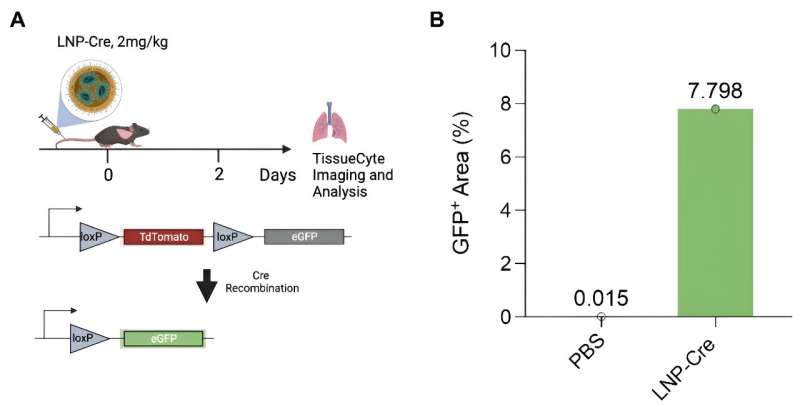June 18, 2024 report
Lung-targeting lipid nanoparticles with CRISPR components successfully treat cystic fibrosis mouse models

A team of medical researchers from the University of Texas Southwestern Medical Center, Case Western Reserve University School of Medicine and ReCode Therapeutics has developed a way to send gene-editing tools to the lungs to repair the faulty gene associated with cystic fibrosis.
In their , published in the journal Science, the group overcame problems that have hampered previous therapies, and believe that their method will soon be used to treat human patients.
Mattijs Bulcaen and Marianne Carlon with KU Leuven, in Belgium, have published a in the same journal issue outlining the work by the team on this new effort.
Cystic fibrosis is a genetic disease that impacts the lungs and GI tract鈥攁 faulty gene results in a sticky mucous buildup in the lungs and throughout the digestive system. Many therapies have been developed to treat symptoms of the disease, but there is still no cure.
In the recent past, researchers have attempted to send gene-editing tools into the lungs to repair the faulty gene, but thus far, such efforts have failed due to the difficulty in getting them past both the immune system and the mucus.
Other efforts have involved sending therapies to the lungs through the bloodstream. They also failed due to the liver filtering them out before they could reach the lungs.
In this new study, the researchers developed a therapy based on this latter approach, but have found a way to prevent it from getting stuck in the liver.
The research team tweaked the gene editing machinery to prevent the lipid nanoparticles from being trapped in the liver. They also tweaked them to target the basolateral side of the lung epithelial lining once they arrived through the bloodstream. This allowed the nanoparticles to find their way to several types of lung cells, including basal cells.
The researchers tested the approach in mice genetically engineered to have human-like cystic fibrosis. The therapy proved to be highly effective鈥攖he researchers found the gene editor had made its way to the desired targets and fixed the mutation in half of the mice being tested.
In monitoring the successfully treated mice, the research team found that it relieved symptoms for up to 22 months.
More information: Yehui Sun et al, In vivo editing of lung stem cells for durable gene correction in mice, Science (2024).
Mattijs Bulcaen et al, Gene editing flows to the lungs, Science (2024).
Journal information: Science
漏 2024 Science X Network




















